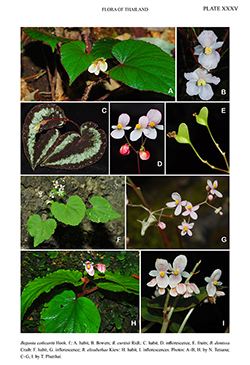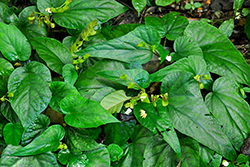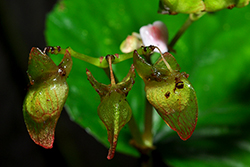e-Flora of Thailand
Volume 14 > Part 3 > Year 2019 > Page 377 > Begoniaceae > Begonia
12. Begonia elisabethae Kiewwfo-0000823911
[§ Parvibegonia], Begonias Penins. Malaysia 98. 2005; Hughes, Annot. Checkl. SE Asian Begonia. 37. 2008. Plate XXXV: H–I.
Accepted Name : This is currently accepted.
Description : Monoecious caulescent herb, 10−20 cm tall. Stems succulent, suberect, glabrous or strigose, pale green or dark red; tubers globose or subglobose with numerous fibrous roots, 5−10 mm diam. Leaves only 2(−3) per plant; petiole pale green, reddish brown when dry, 1−6 cm long; lamina basifixed, succulent, asymmetric, chartaceous when dry, adaxial surface sparsely hairs, light green, dark green or greenish black, iridescent, abaxial surface sparsely hirsute, pale green or vinaceous, ovate-lanceolate, asymmetric, 10−16.5 by 6−8 cm, base cordate, apex acuminate, margin slightly entire or minutely toothed or 3−4 times cuspidate along margin, venation palmate-pinnate, veins 6, midrib prominent beneath. Stipules persistent, pale green, lanceolate, 5−7 by 3−4 mm, apex acute, margin entire and slightly undulate. Inflorescences terminal, dichasial, bisexual, branched 1−4 times, 7−11 cm long, with 8−10 staminate flowers, 2−4 pistillate flowers per branch, protandrous; peduncles, terete, 5−6 cm long, pale green, glabrous. Bracts caducous, pale green with red striation, ovate or boat-shaped, 1−1.5 by 1.5 mm, apex acute, margin entire. Staminate flowers: pedicels 8−15 mm, erect, hairy; tepals 4, plain white or white with red striation, outer 2 obovate, 6−15 by 6−10 mm, base rounded, apex obtuse, margin entire, glabrous or dense uncinate hairs at middle, inner 2 ovate obovate, 5−12 by 2−6 mm, base cuneate, apex obtuse, margin entire, glabrous on both sides; androecium actinomorphic, globose, androphore ca 3 mm long, stamens numerous, yellow, filaments 0.3−0.5 mm long, anthers ovate, ca 1 mm long, dehiscing by short slits near tip, fused at base. Pistillate flowers: pedicels pale green, 4−7 mm long; tepals 5, subequal, obovate, 10−12 by 5−7 mm, white with red striation, base cuneate, apex obtuse, margin entire, inner surface glabrous, outer surface covered with uncinate hairs; ovary with 3 subequal wings, pale green with red striation, 2-locular, placentae bilamellate; styles 2, fused at base, 5−10 mm long, stigma yellow, spiral, stigmatic band crescent-shaped, stigma surface densely papillose. Fruit a dehiscent capsule, pale green with red striation, pendulous, drying pale brown, 18−20 by 10−12 mm; locules ovate, 6−10 by 10−12 mm, abaxial wing nodding, obliquely deltate, ca 20 mm tall, lateral wings deltate, curved along length of capsule, 10 mm tall. Seeds brown, barrel-shaped, 0.4−0.5 mm long, collar cells ca 1/2 length of seed.
Thailand : PENINSULAR: Krabi, Phangnga.
Distribution : Peninsular Malaysia (type).
Ecology : Terrestrial or in limestone rock crevices or on damp streamside soils in dry evergreen forests, 50−100 m alt. Flowering: May–November; fruiting: November–January.
Vernacular : Dat hang nok kaling (ดาดหางนกกะลิง).
Notes: The noticeably elongated leaf tips of this species produce plantlets. Herbarium specimens of Begonia elisabethae and B. vagans may look similar in this respect, however, the fruits differ as they are in different sections of the genus: B. vagans has 3-locular fruit with three equal wings, whilst B. elisabethae has 2-locular fruit with one enlarged wing. Moreover, the inflorescence of B. elisabethae is a compound cyme, whilst in B. vagans it is a raceme of cymes.



